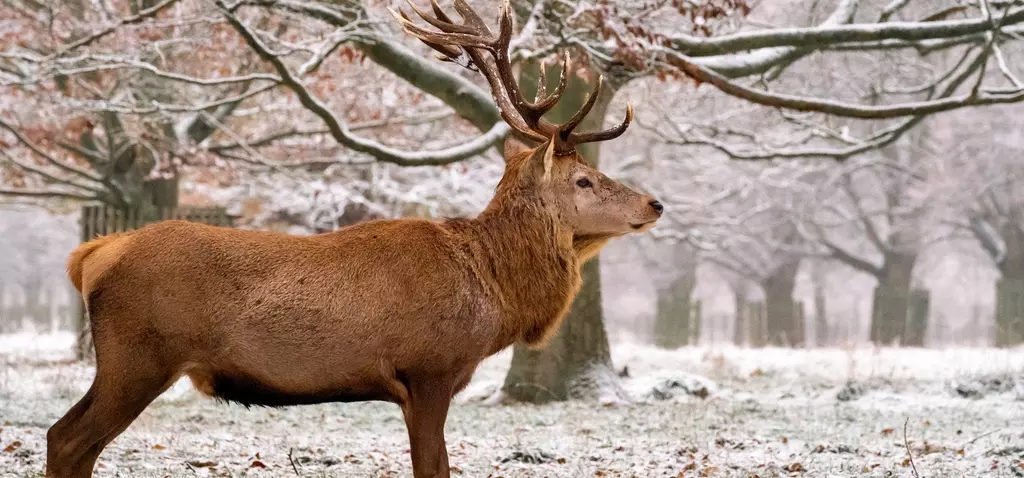marvinwoods.net – The red deer (Cervus elaphus) is one of the largest deer species, inhabiting a wide range of habitats across Europe, Asia, and North Africa. With its impressive antlers (in males), rich reddish-brown coat, and powerful build, the red deer has captivated human imagination for centuries, featuring prominently in mythology, art, and hunting traditions.
Physical Characteristics: A Regal Presence
Red deer are characterized by their robust build and distinctive features:
- Size and Build: Red deer are large animals, with stags (males) standing up to 1.3 meters (4.3 feet) tall at the shoulder and weighing between 160 and 240 kg (350–530 lb). Hinds (females) are smaller, weighing between 100 and 160 kg (220–350 lb).
- Antlers: Stags grow impressive antlers, which are shed annually and regrown each spring. The antlers are branched, with multiple tines (points). The size and complexity of the antlers increase with the stag’s age and health. A mature stag with twelve or more tines on each antler is referred to as a “royal stag.”
- Coat: Red deer have a reddish-brown coat in summer, which turns to a thicker, grayish-brown coat in winter. They have a lighter-colored rump patch.
- Distinctive Features: Their large size, long legs, and impressive antlers (in stags) make them easily recognizable.
Subspecies and Distribution: A Wide Range
Several subspecies of red deer are recognized, inhabiting diverse habitats across their range:
- European Red Deer (Cervus elaphus elaphus): Found throughout Europe.
- Caspian Red Deer (Cervus elaphus maral): Found in the Caucasus region and around the Caspian Sea.
- Bactrian Red Deer (Cervus elaphus bactrianus): Found in Central Asia.
- North African Red Deer (Cervus elaphus barbarus): Found in North Africa.
Introduced populations also exist in countries like Australia, New Zealand, and Argentina.
Habitat and Behavior: Adapting to Diverse Environments
Red deer are adaptable animals, inhabiting a variety of habitats, including forests, woodlands, grasslands, and moorlands.
- Habitat Preferences: They prefer areas with a mix of forest cover for shelter and open areas for grazing.
- Social Behavior: Red deer are social animals, living in herds. During the mating season (rut) in the autumn, stags compete for dominance and the right to mate with hinds.
- Diet: Red deer are primarily grazers, feeding on grasses, forbs, and shrubs. They also browse on leaves, twigs, and bark during the winter months.
The Rut: A Dramatic Display
The red deer rut is a dramatic display of natural behavior:
- Roaring: Stags roar to attract hinds and challenge rival stags. The roar is a deep, guttural call that can be heard for long distances.
- Antler Clashes: Stags engage in antler clashes to establish dominance, pushing and shoving each other until one gives way.
- Harem Formation: Dominant stags gather harems of hinds, which they defend from other stags.
Ecological Role: Shaping Ecosystems
Red deer play an important role in their ecosystems:
- Grazing Impact: Their grazing can influence plant community composition and vegetation structure.
- Seed Dispersal: They can also contribute to seed dispersal.
- Food Source for Predators: Red deer are prey for wolves, bears, and lynx.
Conservation and Management: Balancing Needs
Red deer populations are generally healthy across much of their range, although they are managed through regulated hunting and habitat conservation:
- Hunting Management: Regulated hunting helps to manage red deer populations and prevent overgrazing.
- Habitat Conservation: Protecting and restoring red deer habitat is crucial for their long-term survival.
- Forest Management: Forest management practices can also impact red deer populations, and it’s important to consider their needs in forest planning.
- Human-Wildlife Conflict: In some areas, red deer can cause damage to crops and forestry, leading to conflicts with humans. Management strategies are needed to mitigate these conflicts.
Cultural Significance: A Symbol of Royalty and the Hunt
Red deer have a long history of interaction with humans and hold significant cultural importance:
- Mythology and Folklore: They feature prominently in various myths and legends.
- Hunting Traditions: Red deer have been a prized game animal for centuries, particularly in Europe.
- Art and Literature: They are frequently depicted in art and literature.
Conclusion: A Treasured Part of the Landscape
The red deer is a magnificent animal that represents the wildness and beauty of the landscapes it inhabits. Its powerful presence, dramatic rutting behavior, and ecological role make it a treasured part of European and Asian natural heritage. Through careful management and conservation efforts, we can ensure that these majestic creatures continue to thrive for generations to come.
